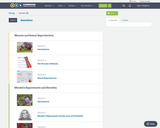
- Subject:
- Biology
- Life Science
- Material Type:
- Unit of Study
- Provider:
- Rice University
- Provider Set:
- OpenStax College

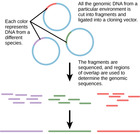
By the end of this section, you will be able to:Explain pharmacogenomicsDefine polygenic

Analyzes computational needs of clinical medicine reviews systems and approaches that have been used to support those needs, and the relationship between clinical data and gene and protein measurements. Topics: the nature of clinical data; architecture and design of healthcare information systems; privacy and security issues; medical expertsystems; introduction to bioinformatics. Case studies and guest lectures describe contemporary systems and research projects. Term project using large clinical and genomic data sets integrates classroom topics.
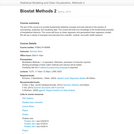
The aim of this course is to provide fundamental statistical concepts and tools relevant to the practice of summarizing, analyzing, and visualizing data. This course will build your knowledge of the fundamental principles of biostatistical inference. The course will focus on linear regression and generalized linear regression models. We will use a variety of examples and exercises from scientific, medical, and public health research.

This task asks students to glean contextual information about bird eggs from a collection of measurements of said eggs organized in a scatter plot. In particular, students are asked to identify a correlation and use it to make interpolative predictions, and reason about the properties of specific eggs via the graphical presentation of the data.

This resource is a video abstract of a research paper created by Research Square on behalf of its authors. It provides a synopsis that's easy to understand, and can be used to introduce the topics it covers to students, researchers, and the general public. The video's transcript is also provided in full, with a portion provided below for preview:
"Birds can carry and transmit viruses to humans and other animals. Thus, understanding the viral community hosted by birds could help us predict future outbreaks of human disease. A recent metagenomics study took a broad look at the viruses found in the gut of wild and captive birds. The dataset included samples from over 3,000 birds that represented over 87 species and 10 different phylogenetic orders and the researchers characterized genomes from numerous viral families including astroviruses, coronaviruses, parvoviruses, and adenoviruses. Examining trends, they found that wild birds had higher viral diversity than captive birds. There was also evidence of potential cross-species transmission between wild birds and domestic poultry. Further analysis of the viral genomic sequences revealed differences in virus distribution patterns between wild and captive birds. Different phylogenetic orders of birds and geographic sites also had distinct distribution patterns..."
The rest of the transcript, along with a link to the research itself, is available on the resource itself.
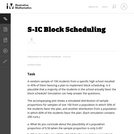
In this task, output is given from a computer-generated simulation, generating size-100 samples of data from an assumed school population of 2000 students under hypotheses about the true distribution of yes/no voters.
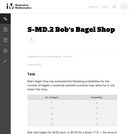
The purpose of this task is to assess a student's ability to compute and interpret an expected value. Notice that interpreting expected value requires thinking in terms of a long-run average.

Students use a tension-compression machine (or an alternative bone-breaking setup) to see how different bones fracture differently and with different amounts of force, depending on their body locations. Teams determine bone mass and volume, calculate bone density, and predict fracture force. Then they each test a small animal bone (chicken, turkey, cat) to failure, examining the break to analyze the fracture type. Groups conduct research about biomedical challenges, materials and repair methods, and design repair treatment plans specific to their bones and fracture types, presenting their design recommendations to the class.
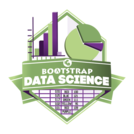
In Bootstrap:Data Science, students form their own questions about the world around them, analyze data using multiple methods, and write a research paper about their findings. The module covers functions, looping and iteration, data visualization, linear regression, and more. Social studies, science, and business teachers can utilize this module to help students make inferences from data. Math teachers can use this module to introduce foundational concepts in statistics, and it is aligned to state and national standards.
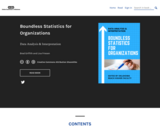
This book is used in Reach Higher, Oklahoma's adult degree completion program, for a course called Data Analysis & Interpretation. It provides basic statistics that can be used for organizational data analysis by individuals with managerial professional goals, while also teaching essential skills from Microsoft Excel commonly needed for data analysis. This book uses material from Lumen Learning's Boundless Statistics (Boundless Learning) and Excel for Decision Making from University of Houston Libraries (multiple authors).

Utopia or dystopia? It’s up to us.
In the 21st century, powerful technologies have been appearing at a breathtaking pace—related to the internet, artificial intelligence, genetic engineering, and more. They have amazing potential upsides, but we can’t ignore the serious risks that come with them.
Brave New Planet is a podcast that delves deep into the most exciting and challenging scientific frontiers, helping us understand them and grapple with their implications. Dr. Eric Lander, president and founding director of the Broad Institute of MIT and Harvard, is a geneticist, molecular biologist, and mathematician who was a leader of the Human Genome Project and for eight years served as a science advisor to the White House for President Obama. He’s also the host of Brave New Planet, and he’s talked to leading researchers, journalists, doctors, policy makers, activists, and legal experts to illuminate how this generation’s choices will shape the future as never before.
Brave New Planet is a partnership between the Broad Institute, Pushkin Industries, and the Boston Globe.
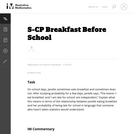
The purpose of this task is to assess a student's ability to explain the meaning of independence in a simple context.
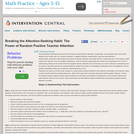
Some students misbehave because they are trying to attract teacher attention. Surprisingly, many students who value adult attention don't really care if it is positive (praise) or negative attention (reprimands)--they just want attention!
Unfortunately, instructors with students who thrive on teacher attention can easily fall into a 'reprimand trap.' The scenario might unfold much like this: First, the student misbehaves. Then the teacher approaches the student and reprimands him or her for misbehaving. Because the student finds the negative teacher attention to be reinforcing, he or she continues to misbehave-and the teacher naturally responds by reprimanding the student more often! An escalating, predictable cycle is established, with the student repeatedly acting-out and teacher reprimanding him or her.
Teachers can break out of this cycle, though, by using 'random positive attention' with students. Essentially, the instructor starts to ignore student attention-seeking behaviors, while at the same time 'randomly' giving the student positive attention. That is, the student receives regular positive teacher attention but at times unconnected to misbehavior. So the student still gets the adult attention that he or she craves. More importantly, the link between student misbehavior and resulting negative teacher attention is broken.
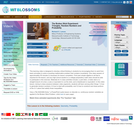
This learning video is designed to develop critical thinking in students by encouraging them to work from basic principles to solve a puzzling mathematics problem that contains uncertainty. Materials for in-class activities include: a yard stick, a meter stick or a straight branch of a tree; a saw or equivalent to cut the stick; and a blackboard or equivalent. In this video lesson, during in-class sessions between video segments, students will learn among other things: 1) how to generate random numbers; 2) how to deal with probability; and 3) how to construct and draw portions of the X-Y plane that satisfy linear inequalities.

A new instructional model, called Argument-Driven Inquiry (ADI), is introduced to elementary teachers in this article. The author shows how school librarians and classroom teachers can collaborate to help students construct and communicate evidence, or arguments. Evidence buckets, a collaborative activity, and related online resources are presented. The article appears in the free online magazine Beyond Weather and the Water Cycle, which is structured around the seven essential principles of climate literacy.

Students will utilize previously gained knowledge about the impact of land management practices on ecosystems to design, conduct and analyze an experiment to measure biodiversity and/or invertebrate ecosystem role in a field community. They will identify ecosystems that have been heavily and lightly impacted by human activities and make predictions about biodiversity in the area. They will then test and analyze the information gathered and apply what this means about the biodiversity in these ecosystems and the implications this may have on the region.
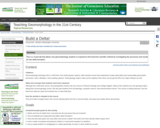
Lab 1: the students begin by describing on a worksheet their own ideas
of delta formation using concept sketches and written descriptions of
the stages of formation, with only broad guidance from the instructor.
They are also asked to describe the key features of their concept
sketches, and to hypothesize how those features might develop (the
processes). The students have all been exposed to deltas in Physical
Geology, but likely only have rudimentary knowledge of them. Once they
have completed the worksheet, the entire class moves to a lab with a
stream table in it, preset to run a "model delta." The model has both a
web cam and a time-lapse web cam set up over the table to record the
development. The students help start the water flowing and the cameras
recording, then watch as it develops over the next 2-3 days.
Lab 2: In the second lab, we use grain-size analysis of the
stream-table delta as a means of testing some of their ideas from lab
1. The students as a class develop a strategy to sample the
stream-table delta for grain size, using a laser grain-size analyzer.
Each pair of students collect one sample, but are also asked to predict
the changes in grain size distribution for samples elsewhere in the
delta. The particle size analyzer rapidly provides results to the
students near the end of lab.
Lab 3: the final lab is a field trip to a pair of gravel pits that
expose the guts of two natural stranded deltas, including topset and
foreset beds. The students are asked to assess the landforms on a topo
map before arriving, and to describe the deposits at each site we
visit. On the final writeup, the students need to synthesize all the
elements of the three labs, along with input from our readings in the
textbook (Easterbrook) and McPhee's "Control of Nature."Â
(Note: this resource was added to OER Commons as part of a batch upload of over 2,200 records. If you notice an issue with the quality of the metadata, please let us know by using the 'report' button and we will flag it for consideration.)

Students investigate the weather from a systems approach, learning how individual parts of a system work together to create a final product. Students learn how a barometer works to measure the Earth's air pressure by building a model using simple materials. Students analyze the changes in barometer measurements over time and compare those to actual weather conditions. They learn how to use a barometer to understand air pressure and predict actual weather changes.

This resource is a video abstract of a research paper created by Research Square on behalf of its authors. It provides a synopsis that's easy to understand, and can be used to introduce the topics it covers to students, researchers, and the general public. The video's transcript is also provided in full, with a portion provided below for preview:
"Tropical maize hybrid, a single cross of flint and dent inbred lines, is an important crop throughout the Americas and Africa. Crop yield, however, is highly dependent on nitrogen availability, and fertilizers are therefore often necessary to increase production. Developing more nitrogen-efficient maize would not only cut costs for farmers, it would also increase crop yield and reduce environmental impacts. But how do you make a plant more nitrogen efficient? The performance and production of crops can be improved by selectively crossing individuals with desired traits. When such plants are crossed, they produce hybrids that are often bigger, stronger, and more vigorous than either of the parent plants. By carefully choosing which individuals are used in creating these hybrids, specific traits, such as nitrogen efficiency, can be selected for..."
The rest of the transcript, along with a link to the research itself, is available on the resource itself.